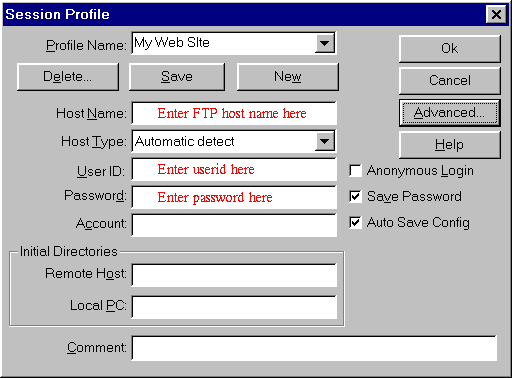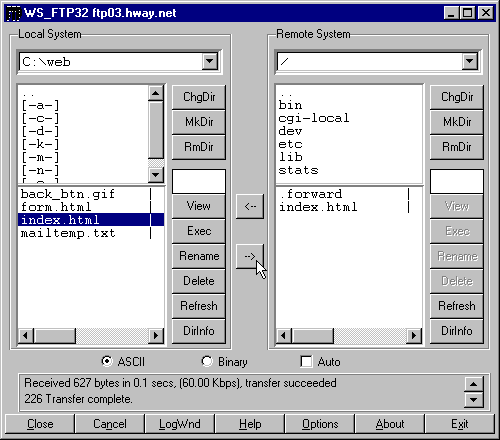

Internet providers such as AOL, Compuserve, and Prodigy may have a built-in FTP interface. If you have a PPP internet account and need an FTP program, you can download software for either the PC (WS_FTP) or Mac (FETCH)from Shareware's web site. You may have to contact your local internet provider to inquire about compatibility. Microsoft FrontPage version 1.1 users whom have had extensions installed within their web site should use FrontPage to transfer files only.
Each time you run WS_FTP the Session Profile window will be displayed. A profile contains the information needed to connect to your web site. Creating a profile now will eliminate the need for you to configure the software each time you wish to connect to the web server via FTP. To create a new profile, click the "New" button and enter a generic profile name at the top of the Session Profile window. Next, enter the userid, password and hostname for your web site as illustrated below.

Be sure to select "Auto detect" for the Host Type. (see Fig.1) It is best to select "Save Password" and "Auto Save Config" to maintain these settings for future use. All other fields can be left blank. You are now ready to connect to the web server. Click "Ok" to continue.

You can transfer files directly to the root level and/or create subdirectories. The only system directory that you may need to use is cgi-local; this directory is reserved for custom scripts. To make your home page load automatically, name the HTML document "index.htm" or "index.html" in lowercase and upload it to the root directory of your account. To upload a file or files, simply highlight the file(s) on the left and click the right-arrow button ("-->") in the center of the screen. Be sure to upload HTML documents and scripts in ASCII mode and images in BINARY mode. To transfer a file to a subdirectory, double-click the appropriate subdirectory to open it before transferring the desired file(s).
As soon as a file is uploaded to the web server, it is available for all to see. If, after uploading a file, you are still unable to see the updated file via Netscape, you need to clear both disk and browser cache. This function can be found by selecting Options > Network Preferences in Netscape. Remember that you must first be connected to the internet through your local internet service provider in order to connect to the web server.
Here's how to chmod a file in...
Windows: when in WS-FTP, right click on the mouse button; go to commands, then go to site. Type chmod 666 filename in the line provided.
Macintosh: when in Fetch, go to the Remote menu; go to Send FTP Commands, then type site chmod 666 filename in the line provided.
Below is a table explaining file permissions:
| Magic Number | Binary | Representation | Permissions |
| 0 | 000 | --- | No permission |
| 1 | 001 | --x | execute |
| 2 | 010 | -w- | write |
| 3 | 011 | -wx | write, execute |
| 4 | 100 | r-- | read |
| 5 | 101 | r-x | read, execute |
| 6 | 110 | rw- | read, write |
| 7 | 111 | rwx | read, write, execute |
chmod on UNIX interprets the first number for owner (yourself), second number for group, and the third for others (everyone else). For example chmod 666 filename will change file permission to read, write for owner, group, and others.
| chmod | Permissions | Meaning |
| 755 | rwxr-xr-x | read, write, and execute for owner; read, execute for everyone |
| 644 | rw-r--r-- | read, write for owner; read for everyone |
| 666 | rw-rw-rw- | read, write for everyone |